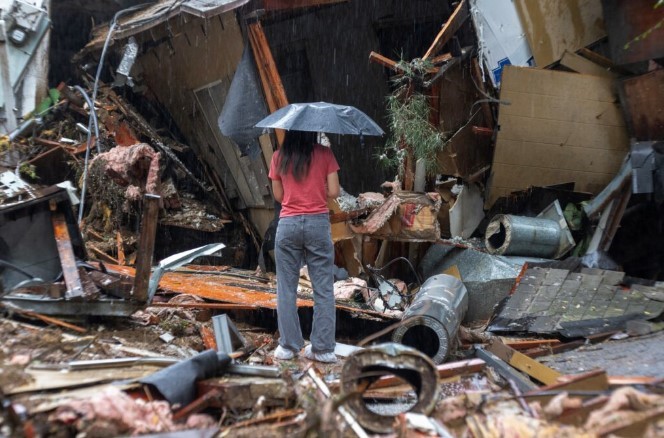
As States Recover from Climate-Related Disasters, They Also Must Prepare for Future Ones
New policies for flooding and wildfires could help people prepare for future damages.
This summer has brought a revolving door of climate-fueled disasters across the U.S.—from Hurricane Beryl in Houston to the wildfires tearing through California.
But what happens in the aftermath of these extreme weather events? For many states, recovery is no longer just about trying to return to normal, but rather rebuilding to prepare for future disasters as climate change accelerates.
A recent string of federal policies and a growing push from the insurance industry has made climate-minded disaster recovery more urgent than ever before, experts say.
Floodplains, Refined: Historically, the Federal Emergency Management Agency (FEMA) has categorized a floodplain as an area with a 1 percent chance of significant annual flooding. This standard has helped determine how and where structures should be rebuilt after a flooding disaster.
However, this definition has largely failed to take the latest climate science into account—until now. The Biden administration issued an executive order on July 10 enabling FEMA to factor growing flood risks from climate change into floodplain assessments. Under that order, FEMA will require that construction projects using the agency's funding are built at a higher elevation or moved out of high-risk areas altogether.
This policy will "enhance resilience in flood-prone communities by taking future flood risk into consideration when we rebuild," FEMA Administrator Deanne Criswell said during a press briefing.
The rule could cost FEMA an estimated additional $150 million over the next decade to elevate or fortify construction against flooding. However, as Grist's Jake Bittle points out, this is a "proportionally small sum given the agency's $3 billion annual disaster spending" and could save the agency money within the next 60 years if it has to respond to less flood-related destruction.
While FEMA covers around 75 percent of emergency recovery during qualifying flood events, that still leaves a quarter of the bill for communities, and some home builders have opposed the ruling in the face of higher costs. The recent overturning of the Chevron doctrine could also reduce FEMA's ability to carry out this type of mandate, but Criswell told The New York Times that she is confident the agency still has legal authority in this scenario.
In January, FEMA also announced increased funds to reimburse local governments for installing energy-efficient technology like solar panels and heat pumps following disasters to help speed up the clean-energy transition.
"After a disaster, communities don't just want to build back. They want infrastructure that will last and will serve them better in a future that promises more extreme weather events fueled by the climate crisis," John Podesta, senior advisor to the president for clean energy innovation and implementation, said in a statement following the announcement.
These decisions come as insurers are raising premiums or pulling out of states such as Florida, battered by supercharged storms and accelerating sea-level rise—a trend my colleague Amy Green wrote about in March.
Fireproofing Homes: Insurers are also getting shaky in the face of wildfires, with major companies like State Farm, Allstate and Farmers limiting coverage in parts of California and Colorado. Here's the economic logic behind some of those decisions: From 2017 to 2018, insurers paid out $29 billion in claims related to California wildfires, while only pulling in $15.6 billion in premiums.
Insurance companies are grappling with how to price climate-related wildfire risks. An insurance reform proposal working its way through California's legislature would expand their options, allowing them for the first time to factor forward-looking climate models into their costs. The catch is that they must offer policies to 85 percent of homeowners in wildfire-distressed areas.
"This is another critical action to help fix California's decades-old insurance crisis. It will help homeowners who face higher threats of wildfire get the coverage they need," California Gov. Gavin Newsom said in support of the plan. "As the climate crisis has rapidly intensified, the insurance system hasn't been seriously reformed in 30 years."
Meanwhile, the Insurance Institute for Business and Home Safety—a nonprofit backed by more than 100 insurance companies—is taking a different approach. The organization is pushing for new standards that would require homeowners to build more fire-resistant homes, both before and after wildfire events, The New York Times reports.
People can take a number of steps to fortify their home and the area around it against an inferno. Experts say to focus on using non-flammable building materials on weak points of the house, including the roof, windows, siding and vents.
Outside the house, "the most common risks are having flammable mulch, plants, firewood, lawn furniture, decks and fences," Bryce Young and Chris Moran, researchers at the University of Montana, write in The Conversation. They both work for wildfire threat assessment research firm Pyrologix. "These items have been a primary reason homes burned in many wildfires."
That includes the 2018 Camp Fire, which virtually decimated the town of Paradise, California. Since then, residents of the town have spent years rebuilding structures to meet rigorous fire-resistance standards in hopes of avoiding a similar fate—a strategy that disaster-impacted communities are following across the country.
Source: İnside Climate News – URL: https://insideclimatenews.org/news/19072024/todays-climate-disaster-preparation-flood-wildfire/